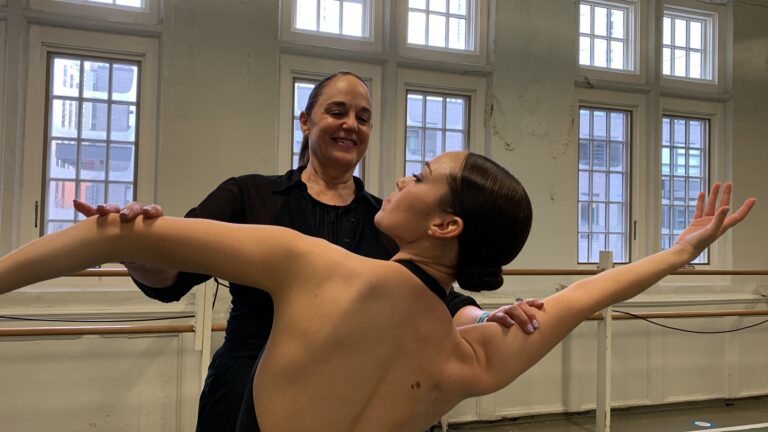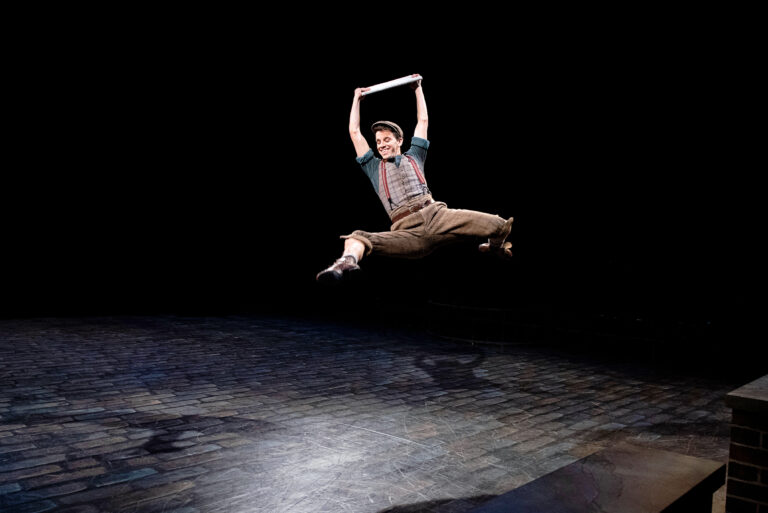
Balancing life as a working parent is tough—particularly when trying to navigate a physical job like teaching dance. As DanceTeacher+ celebrates Mother’s Day, two teachers talk about the challenges they faced during pregnancy, and adjusting to motherhood in the studio.
Trying to Conceive
Chicagoan Wendy Park teaches a variety of classes for ages 5 to 95 at two area dance studios: Dance Center Evanston and A Fairytale Ballet. Park has a rare autoimmune disorder that makes it difficult to maintain a pregnancy. She had six miscarriages before her son, Noen, was born. (Noen is now 5.)
Doctors advised Park not to tell anyone she was pregnant because the chances of miscarriage were so high. “I always told my family immediately,” she says, “but I hid it at work.”
Park says both employers were understanding as she made adjustments during her pregnancies and miscarriages, which included regular treatments and an emergency surgery. But while her direct supervisors knew, keeping the miscarriages a secret from co-workers, students, and parents led to awkward interactions. During and after one miscarriage, Park had two co-workers who were visibly pregnant. The three women taught in side-by-side studios, which Park says led to insensitive comments from parents.
“I remember getting a comment after a recital, and actually being in a pretty happy place for the moment,” she says. “We had just finished the show; my students had done well. It was a nice distraction from what was going on. Some dad in the lobby was like, ‘Clock’s a tickin’!’ I just went and sat by myself.”

Teaching While Pregnant
Maria Hanley is an early-childhood dance educator and mom of three. Though she is now based in Cleveland, Ohio, Hanley’s 8-year-old son, Harrison, was born in New York City, where Hanley taught ages 0 to 6 at Mark Morris Dance Center, Dancewave Center, and 92Y Parenting Center. She implemented an early childhood creative-dance program at the Jewish Community Center of Manhattan and documented many of her experiences teaching “littles” in New York on her blog, Maria’s Movers.
Hanley’s prop-heavy curriculum—made more complicated by being a subway rider working between Manhattan and Brooklyn—led her to seek creative storage solutions. “Where I was teaching, I had to move around the buildings,” she says. “I put a prop bucket—like a soft laundry basket—on a scooter and pulled it around instead of carrying it.”
Hanley moved with her husband, Dan, and the young Harrison from New York to Cleveland in 2014 to be closer to extended family. They have since had two additional children: Landon, born in 2017, and Jacqueline, who is 3 years old.
Hanley worked through those pregnancies as well. “I knew that’s what made me happy,” she says. She taught her creative-movement classes while seated on an exercise ball. “For littles, you sit on the floor a lot,” says Hanley, who continued teaching six days a week during her first pregnancy with Harrison. “[The ball] made it easier to get up and down off the floor so many times.”
Because of Park’s high-risk pregnancy with her son Noen, her OB-GYN recommended bed rest, but the team of doctors treating her autoimmune disorder were giving her conflicting information about the best way to bring the pregnancy successfully to term. For her mental health, Park made the choice to continue working. “I’m shy, but I’m an extrovert,” Park says. “I need to be around people.”
During this time, Park’s father was also dying of cancer. “My husband was working. What was I going to do for 10 hours a day? Sit and cry about my dad and stress out if this baby was going to die? So, I went to work. I like my job.”
Park leaned on demonstrators, and, like Hanley, frequently taught sitting down. She found that learning to teach from a chair and relying on verbal cues while pregnant also helped her teach on Zoom during the pandemic.
“Those are good skills to have,” she says. “You learn how to cadence your voice and use stories.”

Giving Birth—and Teaching While Parenting
With all three pregnancies, Hanley continued teaching until just days before giving birth. Though not entirely planned—Noen was four weeks premature—Park also had a very small gap between an intended break in teaching and giving birth.
Because dance studios often employ teachers as part-time employees or independent contractors, maternity-leave benefits are rare. “I took off seven weeks and then went back, because that was all I could afford, really,” says Hanley, who delivered her three children via C-section. When she returned to work after Harrison was born, Hanley resumed her previous schedule, teaching up to six classes a day.
“Looking back, I wish that I was in a position to not have to work so hard when they were little,” she says. “We just couldn’t because we both work in education and arts.”
Although Hanley wishes she had had the flexibility to lighten her schedule, she doesn’t regret the choice to go back to teaching. “I still believe working makes me a better mom,” she says.
Hanley frequently took Harrison to work with her in a carrier on the New York City subway. She hired a babysitter to meet her at the studio and watch him while she taught (finding it too difficult to wear him while teaching very young children). When Harrison got too big for the carrier, she carted a stroller up and down the subway steps.
Park took three months off when Noen was born in June and resumed teaching the next fall. Dance Center Evanston provided a month’s paid maternity leave, in addition to the summer months she took off. And when she returned, they adjusted her schedule to accommodate lactation breaks.
“At my other job, I had to pump while I taught,” she says. “At first it was really embarrassing. Eventually I just told myself, This is now part of my life. I’m not just teaching ballet. I’m showing these young women sometimes you have to do some odd stuff if you want to try and be a mom and try to have a job.”
Park and her husband, Joe, relied on in-home care for Noen, though she recalls a time when Noen was about 8 months old that her nanny was sick and she had to cart him to the studio. “I didn’t have a garage and was parked, like, three blocks away,” she says. “I had him in the carrier and I had a Pack ‘N’ Play on my arm. I was pouring sweat and crying because it was too hard.”

Getting Their Grooves Back
Park says her body didn’t return to pre-pregnancy shape, which makes the teaching adaptations she learned even more critical. “I never got it back,” Park says. “That’s the hardest thing. I spent six years on and off bed rest. I spent the whole pregnancy not active. Funny: I still have my feet. In every situation I was put in, I could still teach pre-pointe the exact same way.”
Hanley says the built-in activity of living in New York City helped her bounce back quickly from her first pregnancy. Living in a more car-dependent city and the toll of multiple C-sections made her second and third recovery processes more difficult. “As you get older and the more kids you have, it just takes longer,” she says.
One permanent change: Hanley now wears sneakers 100 percent of the time to mitigate pain from being on her feet all day. “When I had Harrison, I would teach in bare feet or in ballet shoes, and now I have to teach in sneakers. That’s made a really big difference on my body.”
Making Compromises
Park still teaches several nights a week and on Saturdays. That has cost her time with her family and her own social life. And if she didn’t have the financial support of her husband, Joe, Park says, she would not be able to afford to do her job.
“There are a lot of things that are hard about this profession—like the pay, the benefits,” says Park. “If I’m going to keep doing a job that meets after school, my kid needs to come to class with me. Otherwise, I have to rethink how I’m going to make my job work around a school-age kid.”
While it’s difficult to juggle, Park is unwavering in her decision to keep teaching. “It’s nice when you’re away from your child to feel like you’re doing something important,” she says. The Parks also decided to homeschool Noen through first grade, affording Park more time with him during the day while Joe cares for Noen in the evenings.
For Hanley, moving to Cleveland meant a lower cost of living and reduced barriers to childcare and housing for her growing family, but she has found her new city challenging to navigate in other ways. “Any of the jobs I’ve had, I created,” she says. “When I moved here, I tried to do the same thing. There just aren’t as many kids.”

Hanley discovered that most working parents in Cleveland relied on full-day childcare centers. Realizing that few Cleveland families had in-home caregivers who could bring small children to dance classes during the day, Hanley found it difficult to build a schedule during the traditional workday and had to take on studio classes three nights a week.
Moreover, Hanley found her second and third pregnancies more complicated, having to juggle working while pregnant and managing childcare for her young children. As her children have gotten older, that has meant time away from Hanley’s family and missing out on extracurricular activities.
“The decision to still work is hard, because you’re basically working to pay the sitter,” says Hanley. And while she tries to balance working and spending time with her family, time off comes at a price. “If you don’t work, you don’t get paid. It’s not like you can take a sick day. That is really challenging, especially trying to support a family of five.”
For Hanley, the trade-off is worth it. “Teaching has made me a better mom,” she says. “I still really love to teach. Having some sort of admin job is not my thing. I’m not willing to compromise my happiness.”
Hanley says her husband, Dan, is extremely supportive and has never pressured her to give up teaching. A silver lining of the pandemic is that he has more flexibility to work from home and help with carpooling. “This is my thing; I’m really good at it,” she says. “I love doing it. I just really want to make it work.”




